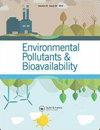Biodegradation of atrazine by three strains: identification, enzymes activities, and biodegradation mechanism
IF 3.2
4区 环境科学与生态学
Q2 BIOCHEMISTRY & MOLECULAR BIOLOGY
Environmental Pollutants and Bioavailability
Pub Date : 2022-11-27
DOI:10.1080/26395940.2022.2151515
引用次数: 1
Abstract
ABSTRACT Biodegradation could remove atrazine from contaminated soil and water. In this work, three isolated bacterial strains D2, D6, and D17 were identified as Solibacillus, Bacillus, and Arthrobacter, respectively.They can rapidly degrade atrazine and effectively alleviate the phytotoxic effects of atrazine, with degradation efficiency following D2> D6>D17. Besides having the highest amount of exoenzyme and endoenzyme, the highest exoenzyme ratio in strain D2 also contributed to the highest atrazine degradation, as exoenzyme facilitated the direct reaction with atrazine in a short time and alleviated the stress of pollutant on strains, while more endoenzyme for D6 and D17 indicated degradation acted only after across the membrane, which needs more time to degradation. Furthermore, trzN in strain D2 can degrade atrazine to hydroxyatrazine. The biodegradation product of atrazine by strain D2 was cyanuric acid via dichlorination, hydroxylation, hydrodealkylation, methylation, dealkylation, elimination, and hydrolysis.三种菌株对阿特拉津的生物降解:鉴定、酶活性和生物降解机制
生物降解可去除土壤和水体中的阿特拉津。本研究分离的3株细菌D2、D6和D17分别鉴定为固体芽孢杆菌、芽孢杆菌和节杆菌。它们能快速降解阿特拉津,有效缓解阿特拉津的植物毒性作用,降解效率为D2> D6>D17。除了胞外酶和内酶含量最高外,胞外酶比例最高的菌株D2降解阿特拉津的能力也最高,因为胞外酶能在短时间内与阿特拉津直接反应,减轻了污染物对菌株的胁迫,而胞内酶含量较高的菌株D6和D17则表明降解需要过膜后才能进行,需要更长的降解时间。此外,菌株D2中的trzN可以降解阿特拉津生成羟基阿特拉津。菌株D2对阿特拉津经二氯化、羟基化、加氢脱烷基、甲基化、脱烷基、消除和水解后的生物降解产物为氰尿酸。
本文章由计算机程序翻译,如有差异,请以英文原文为准。
求助全文
约1分钟内获得全文
求助全文
来源期刊

Environmental Pollutants and Bioavailability
Chemical Engineering-Chemical Health and Safety
CiteScore
4.30
自引率
3.00%
发文量
47
审稿时长
13 weeks
期刊介绍:
Environmental Pollutants & Bioavailability is a peer-reviewed open access forum for insights on the chemical aspects of pollutants in the environment and biota, and their impacts on the uptake of the substances by living organisms.
Topics include the occurrence, distribution, transport, transformation, transfer, fate, and effects of environmental pollutants, as well as their impact on living organisms. Substances of interests include heavy metals, persistent organic pollutants, and emerging contaminants, such as engineered nanomaterials, as well as pharmaceuticals and personal-care products as pollutants.
 求助内容:
求助内容: 应助结果提醒方式:
应助结果提醒方式:


